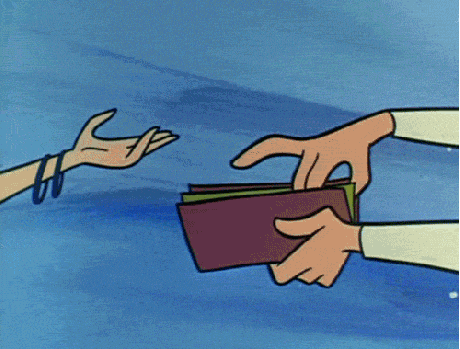Each academic year, college students apply for financial aid using the FAFSA application. But you and I both know the amount you get just doesn’t cut it sometimes. What if another form of aid exists that you didn’t know about? The Federal Pell Grant works on a need-based platform to give money to low-income students to help pay for the costs of attending college. While it differs from the FAFSA in many ways, it all results in you getting more funds to help you get through your college experience.
Here’s everything you need to know about the grant you don’t need to pay back!
What’s a Pell Grant?

The Pell Grant, awarded by the U.S Department of Education, helps eligible low-income students pay for college costs. It’s the largest grant program offered by the Department of Education to undergraduate students, and has awarded grants to students since 1973. Fun fact! The Pell Grant was named after Senator Claiborne Pell of Rhode Island, the chief sponsor of the program.
“I found out about the Pell grant through FAFSA. It’s not a difficult application, [and] I was automatically considered for the grant through FAFSA. I apply every year and the amount that I receive for the year is pretty helpful!” Pell Grant recipient Alexandra Mendez said.
This need-based federal grant doesn’t need to be repaid, aka, a major reason why you should apply. It will help pay for college costs, including tuition, fees, room and board and other educational expenses. At this point, you should open another tab to check it out. Need more information for all of you skeptical folks?
How Do I Apply?

Now, you might wonder how or where you can even get your hands on this application. The first step to receiving a Pell Grant? Completing and submitting the FAFSA. A family’s information on the FAFSA, including income and number of children enrolled in college generates a number known as the student’s expected family contribution, or EFC. Your EFC determines whether or not you qualify to receive the Pell Grant.
“The FAFSA is an application that’s going to cover Federal Pell Grants and federal student loans. On the homepage of that application website, which is fasfa.gov, there are headers that explain the programs and its processes. That’s a great resource to use depending on the topic you’re questioning, or you can use the resource link at the bottom of the page that would pull up a paper copy of the application. The paper copy has a lot more information on it than what you’d see online,” Federal Student Aid Information Center employee Janet Mead said.
The Pell Grant varies from other forms of aid because a student’s eligibility does not vary across schools. As long as the institution participates in the federal student aid program, they will still consider you for eligibility. Even if a family or student thinks they won’t qualify for the Pell Grant, they should still fill out and submit the FAFSA! It’s required for all federal financial aid, not just the Pell Grant, and nearly all students who apply qualify for some form of this aid.
“It’s best to apply as soon as the application comes out. That helps you avoid any last-minute delays with your application. Sometimes if there’s any mistakes on the application you’ll have to do it again and it delays when you get the money. There may also be technical difficulties sometimes. The quicker the better,” Federal Student Aid Information Center employee Kaitlyn Hasher said.
Time to get your laptop ready to apply that application when it drops!
What’s the Deadline?

Normally, the federal deadline to file the FAFSA falls on June 30, but some states retain earlier deadlines. Oftentimes, schools encourage you to file your FAFSA early because it works on a first-come, first-serve basis—but that’s just another factor that differentiates this grant. It’s determined by eligibility, and even if you miss a deadline, you can still receive a Pell Grant.
“The money you get from your FAFSA application actually doesn’t affect the amount you get from the Pell Grant. The application is only reviewed to determine whether or not you qualify as a low-income student. So, if you think you make ‘too much’ from FAFSA to qualify or receive a reasonable amount from the Pell grant, there’s no need to feel worried,” Federal Student Aid Information Center Employee Henry Douqual said.
Yup, that’s right! You don’t need to worry about your FAFSA affecting your Pell Grant as it comes as an entirely separate form of aid that’s need-based. You can receive up to $6,495 just from the Pell.
How Do I Get My Money?

A student’s Pell Grant amount depends on their EFC, the amount of the tuition per academic year and whether the student studies part-time or full-time. Colleges and universities use a chart from the Department of Education which gets updated annually to calculate a student’s Pell Grant award each year based on these factors. Exactly when and how a student gets paid depends on the school they attend. You may get your payment as early as 10 days before the first day of classes, or they may send monthly payments. But either way, it’s one less bill to worry about.
“A college or university will distribute the Pell Grant funds directly to the student in payments called disbursements. The federal government will then reimburse the institution. Typically, an institution puts the Pell Grant award in the student’s account balance automatically to cover tuition, fees and room and board,” Montclair State University Financial Director Jim Anderson said.
The best part? You don’t need to repay the money! Many students and parents feel skeptical about federal aid since it’s usually expected that the student will repay the money when they graduate. Not to mention paying interest on the loans you took out in the future, as well. It’s almost like being in a toxic relationship with your loans. Since you don’t need to repay the Pell Grant, you won’t be in a life-long tie with the government for this grant.
What’s the Catch?

Not all schools participate in Pell Grant funds and the funds don’t get considered as taxable income. You should remain aware that withdrawing from courses or changing enrollment status after schools disburse Pell Grant awards may have tax implications and may require students to repay their award.
“Students should view it as a significant source of aid, but also understand it is only a part of the larger financial aid picture,” St. John’s University Economics Professor Dr. Vipul Bansal said.
Pell Grants become limited to students with financial needs; for instance, students without a first bachelor’s degree or not enrolled in certain post-baccalaureate programs, through participating institutions. The Department of Education established lifetime limits for Pell Grant funding. A student can only receive up to 600 percent (six years) of this subsidy. Once you reach this limit, the student can’t receive any additional Pell awards.



















